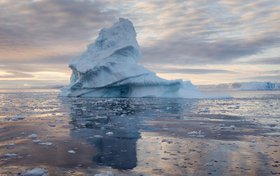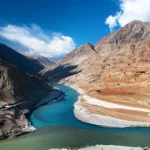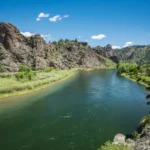
More fish species are found in the Arctic Ocean than anywhere else in the world.
The Arctic Ocean is located around the North Pole and almost completely surrounded by Eurasia and North America.
There is a wide variety of marine life living in the Arctic Ocean, including jellyfish, whales, fish, seals and walruses.
It is the smallest and shallowest of the world’s five major oceans.
Polar bears live and hunt on the ice of the Arctic Ocean.
The Arctic Ocean covers approximately 4% of the Earth’s surface.
There are 4 whale species in the Arctic Ocean including the bowhead whale, grey whale, narwhal, and beluga whale.
It covers an area of approximately 14,056,000 square kilometers (5,427,000 square miles), which is more than the area of Europe.
There are six seal species living in the Arctic Ocean including the bearded seal, ribbon seal, ringed seal, spotted seal, harp seal, and the hooded seal.
The Titanic sank because it ran into an iceberg that had broken away from a glacier from the Arctic Ocean.
Fast ice is the ice that forms during the winter around the pack ice and land around the Arctic Ocean.
When the ice of the Arctic Ocean melts it releases nutrients and organisms into the water which promotes the growth of algae. The algae feed zooplankton which serves as food for the sea life.
The Arctic Ocean has a volume of 18,750,000 cubic kilometers (4,500,000 cubic miles).
When the sea creatures that live under the ice of the Arctic Ocean they serve as a food source for bottom dwellers such as sea anemones and sponges.
The average depth of the Arctic Ocean is 1,038 metes (3,406 feet). The deepest point is Litke Deep in the Eurasian Basin, at 5,450 meters (17,880 feet).
Although the Arctic Ocean is covered by an ice cap, the ice cap is decreasing in size due to global warming and pollution. If it continues to melt it is possible that eventually there will be no more ice in the Arctic Ocean. This may happen by the year 2040.
The ice located at the edge of the polar ice is called pack ice, which only freezes completely in the winter.
The coastline is 45,390 kilometers (28,200 miles) long.
Countries bordering the Arctic Ocean are: Russia, Norway, Iceland, Greenland, Canada and the United States.
The Arctic Ocean is generally taken to include Baffin Bay, Barents Sea, Beaufort Sea, Chukchi Sea, East Siberian Sea, Greenland Sea, Hudson Bay, Hudson Strait, Kara Sea, Laptev Sea, White Sea and other tributary bodies of water.
The Arctic Ocean is connected to the Pacific Ocean by the Bering Strait and the Atlantic Ocean by the Greenland Sea.
It is partly covered by sea ice throughout the year and almost completely in winter.
Polar ice doesn’t melt and can be as thin as 2 meters in the summer and 50 meters thick in the winter months.
The large expanse of sea ice keeps the polar regions cool and affects the global climate.
The mean extent of the ice has been decreasing since 1980.
Because of the Arctic Ocean’s low evaporation, large freshwater inflow, and its limited connection to other oceans it has the lowest salinity of all oceans. Its salinity varies depending on the ice covers’ freezing and melting.
The Arctic may become ice free for the first time in human history by 2040.
The polar sea ice is frozen seawater, while the icebergs are frozen freshwater that originates from molten glaciers on the lands surrounding the Arctic Ocean.
Icebergs occasionally break away from northern Ellesmere Island, and icebergs are formed from glaciers in western Greenland and extreme northeastern Canada. These icebergs pose a hazard to ships, of which the Titanic is one of the most famous.
Three types of ice cover the Arctic Ocean including polar ice, fast ice, and pack ice.
The North Pole is located in the Arctic Circle.
The largest known iceberg in the North Atlantic was 168 meters (551 feet) above sea level, reported by the USCG icebreaker East Wind in 1958, making it the height of a 55-story building.
The temperature of the surface of the Arctic Ocean is fairly constant, near the freezing point of seawater. Because the Arctic Ocean consists of saltwater, the temperature must reach −1.8 °C (28.8 °F) before freezing occurs.
The Arctic Ocean’s salinity is the lowest on average of the five major oceans, due to low evaporation, heavy fresh water inflow from rivers and streams, and limited connection and outflow to surrounding oceanic waters with higher salinities.
Daylight is constant throughout the summer, while total darkness surrounds the Arctic Ocean during the winter months.
The Arctic Ocean provides an unlikely home for a spectrum of enchanting creatures. Above the ice and below, beluga whales, narwhals, bowhead whales, walruses, seals, murres prosper, brown bears, arctic wolves and arctic foxes. Polar bears remain the most iconic Arctic species, and live only in this landscape.
The Arctic Ocean encompasses an area of 5,427,000 square miles. This is almost the same size as Russia.
Climate change is an enormous threat to polar bears. Polar bears rely on sea ice to access the seals that are their primary source of food as well as to rest and breed.
The name “Arctic” comes from the Greek word “Arktos,” meaning “Bear,” because the Great Bear, or Ursa Major constellation, is seen just above the North Pole.
Fridtjof Nansen was the first person to make a nautical crossing of the Arctic Ocean, in 1896.
Approximately 25% of the undiscovered petroleum is believed to be located in the Arctic Ocean.
The first surface crossing of the ocean was led by Wally Herbert in 1969, in a dog sled expedition from Alaska to Svalbard, with air support.
If the ice disappears, the polar bears living and hunting on the ice of the Arctic Ocean will disappear. They rely on the ice to serve as a platform when they hunt. Without the ice platforms they will starve.
Since 1937, Soviet and Russian manned drifting ice stations have extensively monitored the Arctic Ocean. Scientific settlements were established on the drift ice and carried thousands of kilometres by ice floes.
The Arctic Ocean boasts several important ports and harbors like Churchill (Canada), Murmansk (Russia) and Prudhoe Bay (US).
The political dead zone near the centre of the sea is also the focus of a mounting dispute between the United States, Russia, Canada, Norway, and Denmark. It is significant for the global energy market because it may hold 25% or more of the world’s undiscovered oil and gas resources.
The climate of the Arctic region has varied significantly in the past. As recently as 55 million years ago, the region reached an average annual temperature of 10–20 °C (50–68 °F).









